Effect of Indenter Nose Shape and Layer Configuration on the Quasi-Static Perforation Behaviour of Metal–Plastic Laminates
Abstract
:1. Introduction
2. Materials and Methods
2.1. Materials
2.2. Laminate Preparation
2.3. Quasi-Static Perforation Experiments
2.4. Failed Specimen Characterisation
3. Results
3.1. Monolithic Laminates
3.1.1. Force–Displacement Profile
3.1.2. Perforation Energy and Peak Force to Failure
3.1.3. Monolithic Failure Mechanisms
3.2. Bilayer Laminates
3.2.1. Force–Displacement Profiles
3.2.2. Perforation Energy and Peak Force to Failure
3.2.3. Bilayer Failure Mechanisms
3.3. Trilayer Sandwiched Laminates
3.3.1. Force–Displacement Profiles
3.3.2. Specific Perforation Energy and Peak Force to Failure
3.3.3. Trilayer Failure Mechanisms
3.4. Comparison of the Perforation Energy without Adhesive
3.5. FTIR Spectra of Laminates with Adhesive
4. Discussion
5. Conclusions
- For monolithic laminates, the blunt indenter showed the greatest perforation energy capacity for both Al and HDPE, followed by the hemispherical and conical indenters. In particular, HDPE showed a 191% increase in perforation energy compared with Al with the blunt indenter. Circumferential cracking, radial symmetric cracking and shear plugging were the main failure modes for Al in the perforation loading under the hemispherical, conical and blunt indenters, respectively.
- In Al–HDPE bilayer laminates, for the hemispherical indenter, having HDPE facing the indenter tip was more effective for perforation resistance, showing a ~26% increase compared with the case when Al faced the indenter. On the other hand, it was the opposite for the conical and blunt indenters, in which having Al facing the indenter produced higher perforation energy, which accounted for increases of about 19% and 11% with the conical and blunt indenters. The deformation and failure mechanism of the laminates apparently matched that of their monolithic equivalents.
- For all indenters, the adhesive at the interface of the bilayers detached from the Al surface after fracture of the Al through crack propagation. Detachment of the adhesive was more severe with Al as a backing, i.e., when the indenter faced HDPE. This was quite noticeable for the conical indenter. On the other hand, the adhesive stuck well to the Al and provided extra support through plastic stretching until the perforation.
- In trilayer laminates, Al–HDPE–Al showed higher perforation resistance than HDPE–Al–HDPE. The additional HDPE layer in the trilayer HDPE–Al–HDPE laminate did not boost the perforation resistance beyond the bilayer Al–HDPE. The hemispherical and blunt indenters showed almost the same perforation energy, while the conical indenter had the lowest. This resembled the performance of their monolithic equivalents. The failure mode of the tri-layer laminates followed a similar trend and mechanism to the bilayer laminates.
- Confirmed by the FTIR data, the hybrid polymer-based adhesive used for bonding contributed very marginally to the increase of the perforation energy and peak force to failure in laminates. The increase was found to be more prominent for bilayers as opposed to trilayers. Neck retardation due to the adhesive might be the mechanism of the higher perforation energy.
Author Contributions
Funding
Institutional Review Board Statement
Informed Consent Statement
Data Availability Statement
Conflicts of Interest
References
- Nassier, A.; Birch, R.S.; Cantwell, W.J.; Al Teneiji, M.; Guan, Z.W. The perforation resistance of aluminum-based thermoplastic FMLs. Appl. Compos. Mater. 2021, 28, 587–605. [Google Scholar] [CrossRef]
- Vlot, A. Impact loading on fibre metal laminates. Int. J. Impact Eng. 1996, 18, 291–307. [Google Scholar] [CrossRef]
- Abdullah, M.R.; Prawoto, Y.; Cantwell, W.J. Interfacial fracture of the fibre-metal laminates based on fibre reinforced thermoplastics. Mater. Des. 2015, 66, 446–452. [Google Scholar] [CrossRef]
- Ahmadi, H.; Ekrami, M.; Sabouri, H.; Bayat, M. Experimental and numerical investigation on the effect of projectile nose shape in low-velocity impact loading on fiber metal laminate panels. Proc. Inst. Mech. Eng. Part G J. Aerosp. Eng. 2019, 233, 3665–3679. [Google Scholar] [CrossRef]
- Zhang, J.; Ye, Y.; Qin, Q.; Wang, T. Low-velocity impact of sandwich beams with fibre-metal laminate face-sheets. Compos. Sci. Technol. 2018, 168, 152–159. [Google Scholar] [CrossRef]
- Zhang, J.; Ye, Y.; Qin, Q. On dynamic response of rectangular sandwich plates with fibre-metal laminate face-sheets under blast loading. Thin-Walled Struct. 2019, 144, 106288. [Google Scholar] [CrossRef]
- Zhang, J.; Zhu, Y.; Li, K.; Yuan, H.; Du, J.; Qin, Q. Dynamic response of sandwich plates with GLARE face-sheets and honeycomb core under metal foam projectile impact: Experimental and numerical investigations. Int. J. Impact Eng. 2022, 164, 104201. [Google Scholar] [CrossRef]
- Mohagheghian, I.; McShane, G.J.; Stronge, W.J. Quasi-static and impact perforation of polymer-metal bi-layer plates by a blunt indenter. Thin-Walled Struct. 2017, 117, 35–48. [Google Scholar] [CrossRef]
- Iqbal, M.A.; Gupta, G.; Diwakar, A.; Gupta, N.K. Effect of projectile nose shape on the ballistic resistance of ductile targets. Eur. J. Mech.-A/Solids 2010, 29, 683–694. [Google Scholar] [CrossRef]
- Palomby, C.; Stronge, W.J. Blunt missile perforation of thin plates and shells by discing. Int. J. Impact Eng. 1988, 7, 85–100. [Google Scholar] [CrossRef]
- Atkins, A.G.; Afzal khan, M.; Liu, J.H. Necking and radial cracking around perforations in thin sheets at normal incidence. Int. J. Impact Eng. 1998, 21, 521–539. [Google Scholar] [CrossRef]
- Backman, M.E.; Goldsmith, W. The mechanics of penetration of projectiles into targets. Int. J. Eng. Sci. 1978, 16, 1–99. [Google Scholar] [CrossRef]
- Teng, X.; Dey, S.; Børvik, T.; Wierzbicki, T. Protection performance of double-layered metal shields against projectile impact. J. Mech. Mater. Struct. 2007, 2, 1309–1329. [Google Scholar] [CrossRef]
- Roland, C.M.; Fragiadakis, D.; Gamache, R.M. Elastomer–steel laminate armor. Compos. Struct. 2010, 92, 1059–1064. [Google Scholar] [CrossRef]
- Radin, J.; Goldsmith, W. Normal projectile penetration and perforation of layered targets. Int. J. Impact Eng. 1988, 7, 229–259. [Google Scholar] [CrossRef]
- Liu, Y.; Liaw, B. Drop-weight impact tests and finite element modeling of cast acrylic/aluminum plates. Polym. Test. 2009, 28, 808–823. [Google Scholar] [CrossRef]
- Xue, L.; Mock, W.; Belytschko, T. Penetration of DH-36 steel plates with and without polyurea coating. Mech. Mater. 2010, 42, 981–1003. [Google Scholar] [CrossRef]
- Mohagheghian, I.; McShane, G.J.; Stronge, W.J. Impact perforation of polymer–metal laminates: Projectile nose shape sensitivity. Int. J. Solids Struct. 2016, 88–89, 337–353. [Google Scholar] [CrossRef]
- Taghizadeh, S.A.; Liaghat, G.; Niknejad, A.; Pedram, E. Experimental study on quasi-static penetration process of cylindrical indenters with different nose shapes into the hybrid composite panels. J. Compos. Mater. 2019, 53, 107–123. [Google Scholar] [CrossRef]
- Johnson, H.E.; Louca, L.A.; Mouring, S.; Fallah, A.S. Modelling impact damage in marine composite panels. Int. J. Impact Eng. 2009, 36, 25–39. [Google Scholar] [CrossRef] [Green Version]
- Sutherland, L.S.; Soares, C.G. The use of quasi-static testing to obtain the low-velocity impact damage resistance of marine GRP laminates. Compos. Part B Eng. 2012, 43, 1459–1467. [Google Scholar] [CrossRef]
- Stevens, G.C. Method of Treating a Surface. 2021. Available online: https://patents.google.com/patent/WO2021258126A1/en?oq=PCT%2fAU2020%2f050650 (accessed on 17 August 2022).
- Grujicic, M.; Pandurangan, B.; He, T.; Cheeseman, B.A.; Yen, C.-F.; Randow, C.L. Computational investigation of impact energy absorption capability of polyurea coatings via deformation-induced glass transition. Mater. Sci. Eng. A 2010, 527, 7741–7751. [Google Scholar] [CrossRef]
- Xue, Z.; Hutchinson, J.W. Neck retardation and enhanced energy absorption in metal–elastomer bilayers. Mech. Mater. 2007, 39, 473–487. [Google Scholar] [CrossRef]
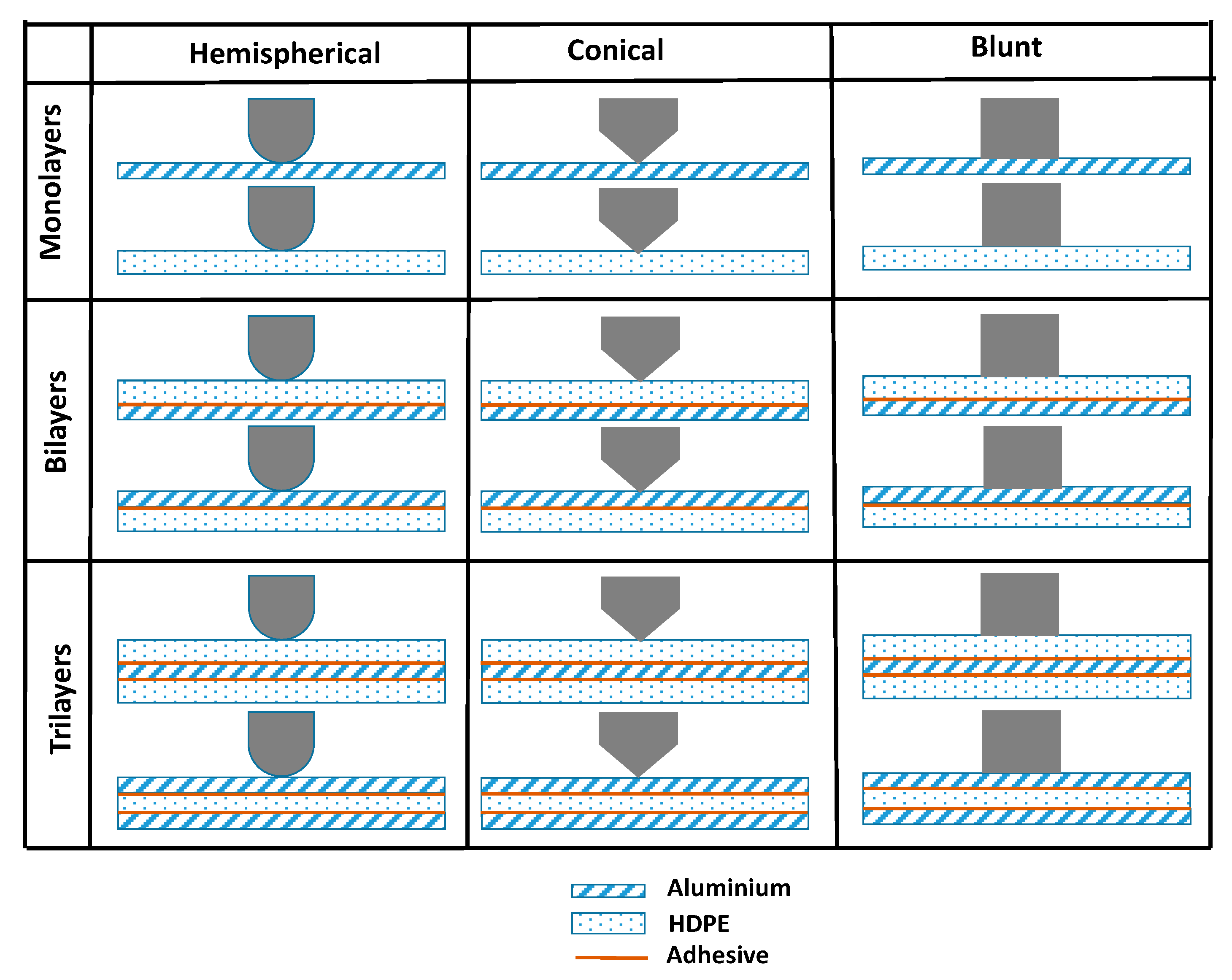
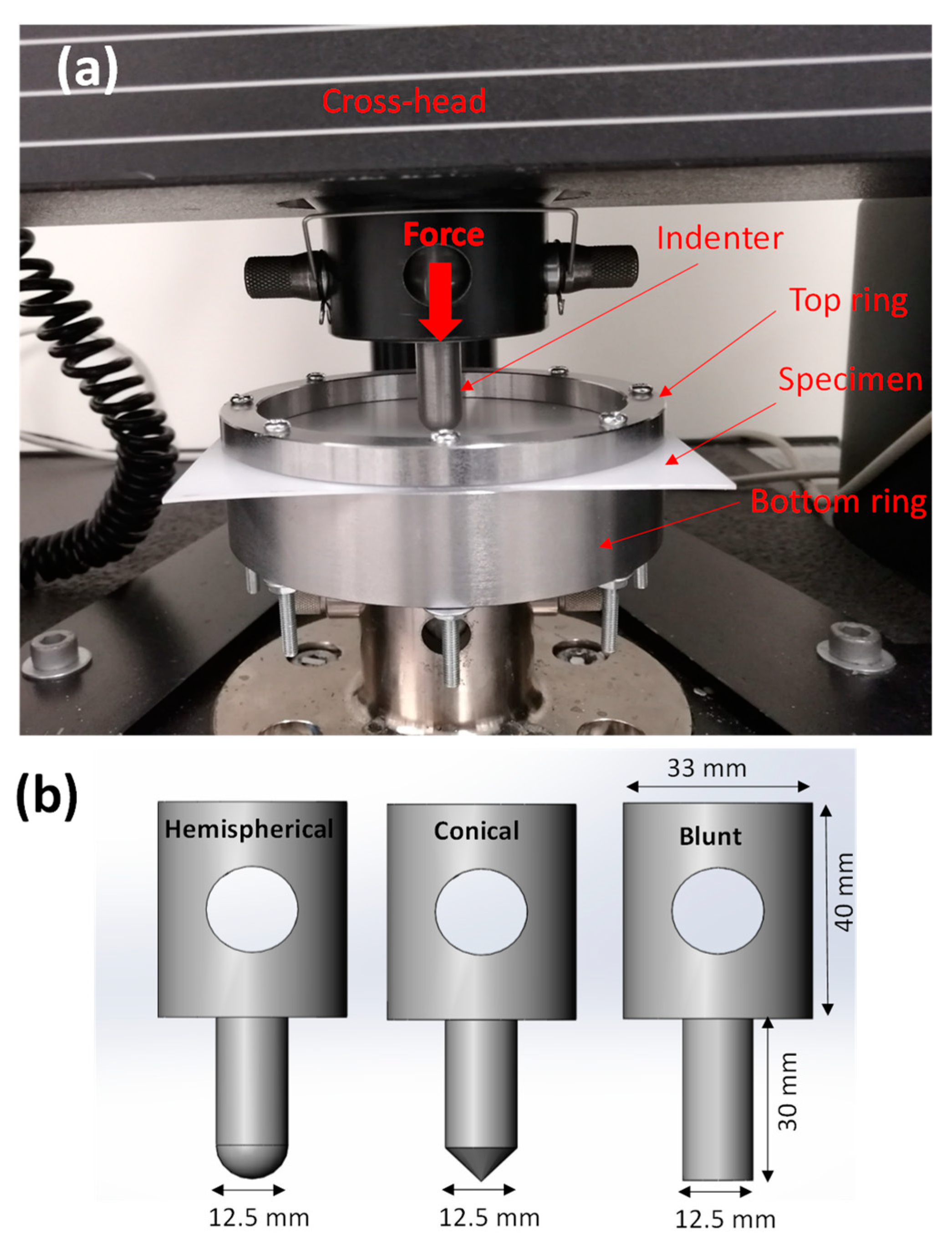


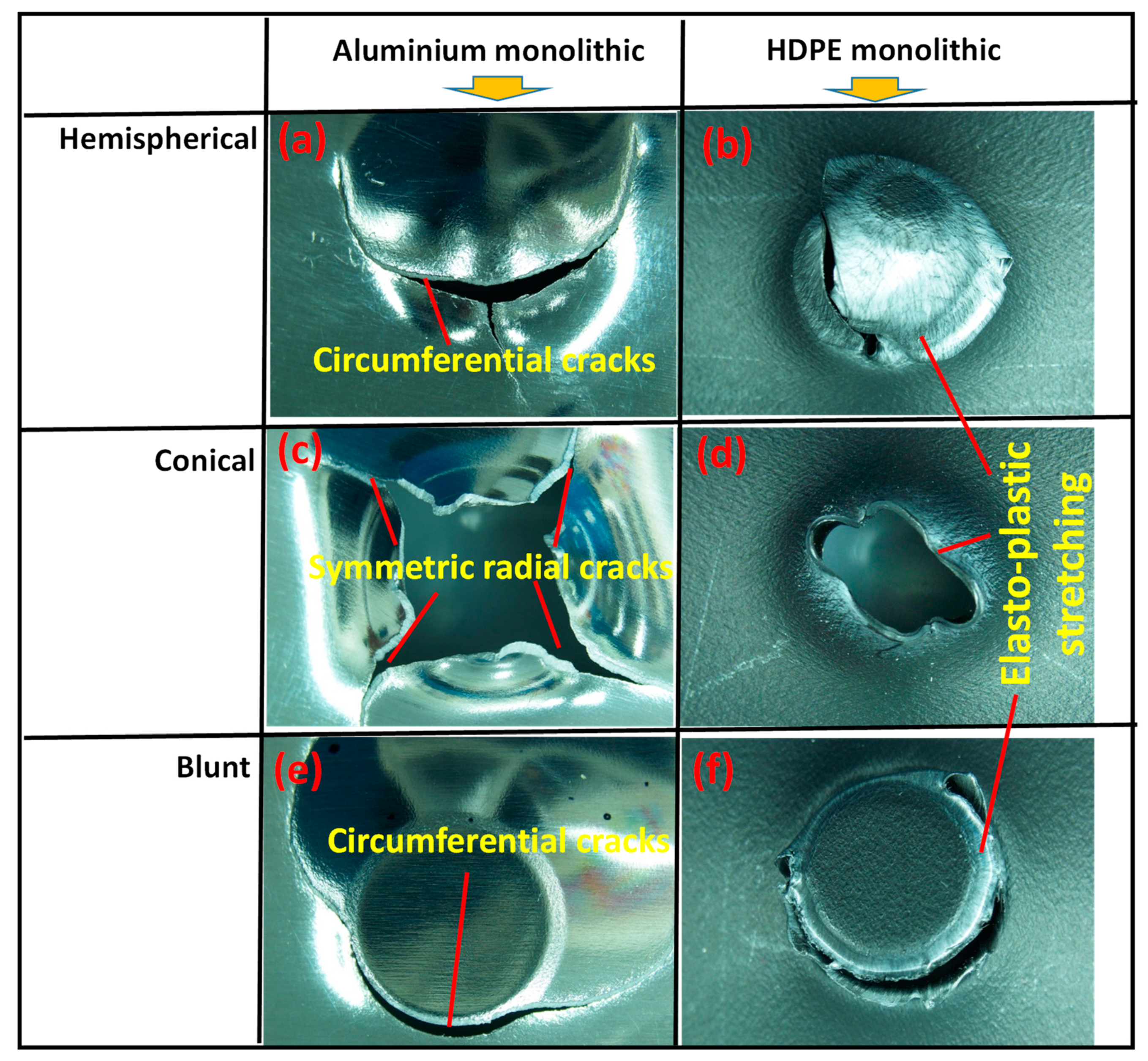
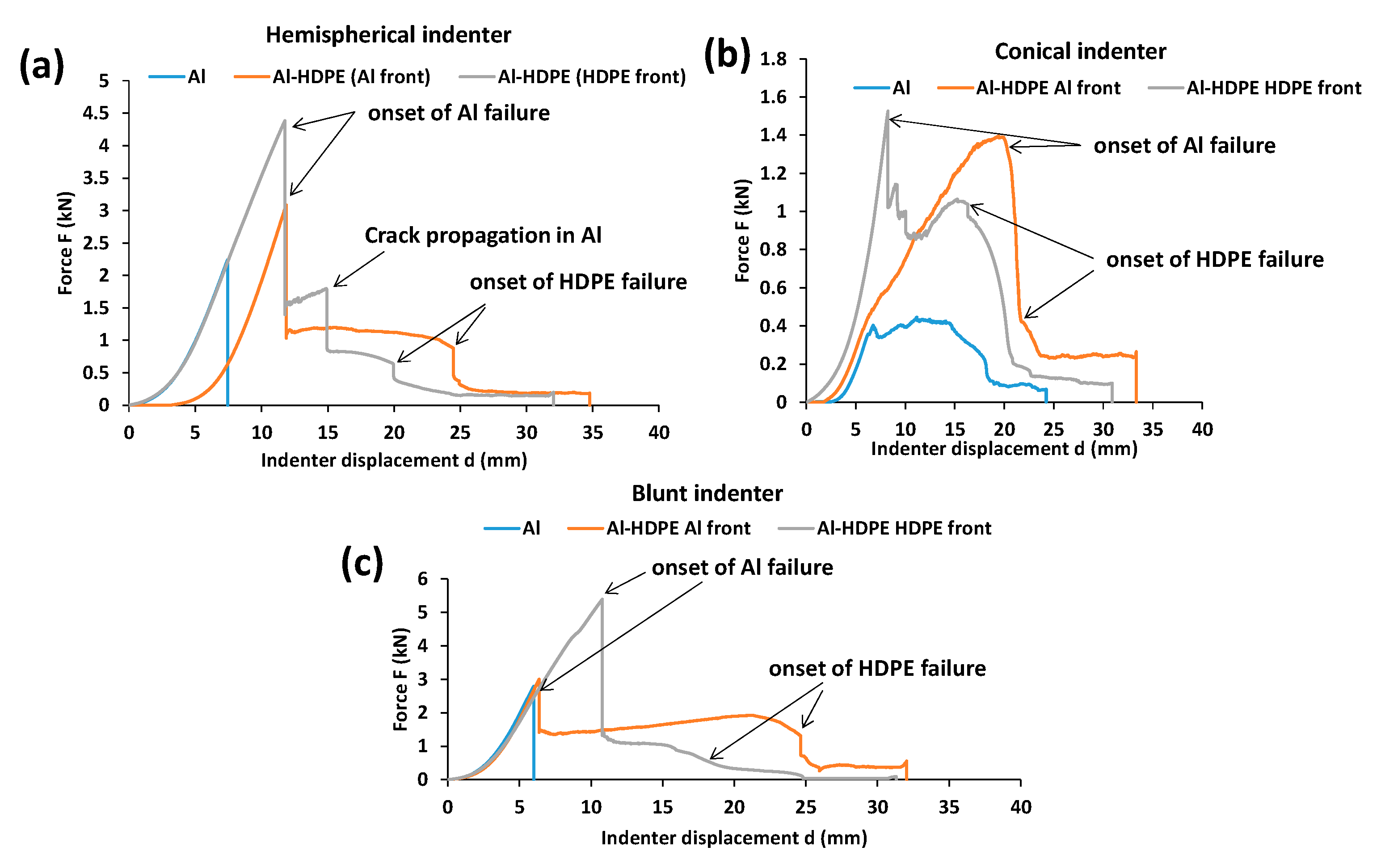


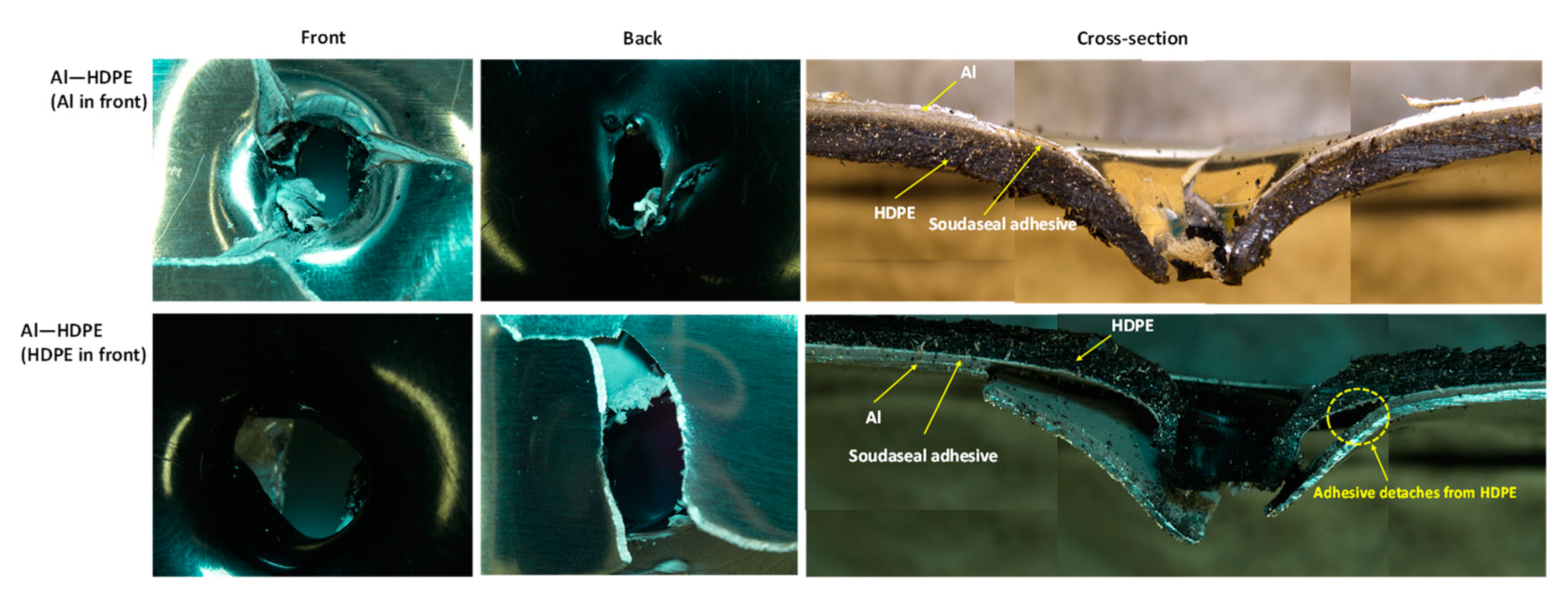
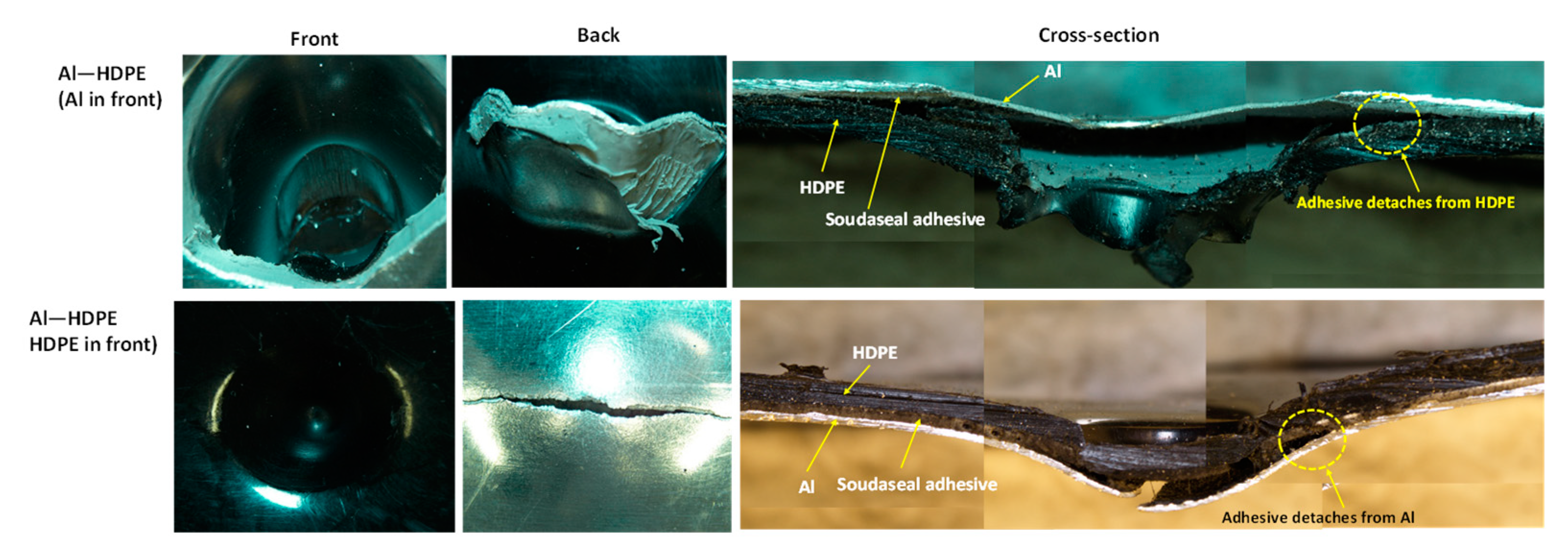
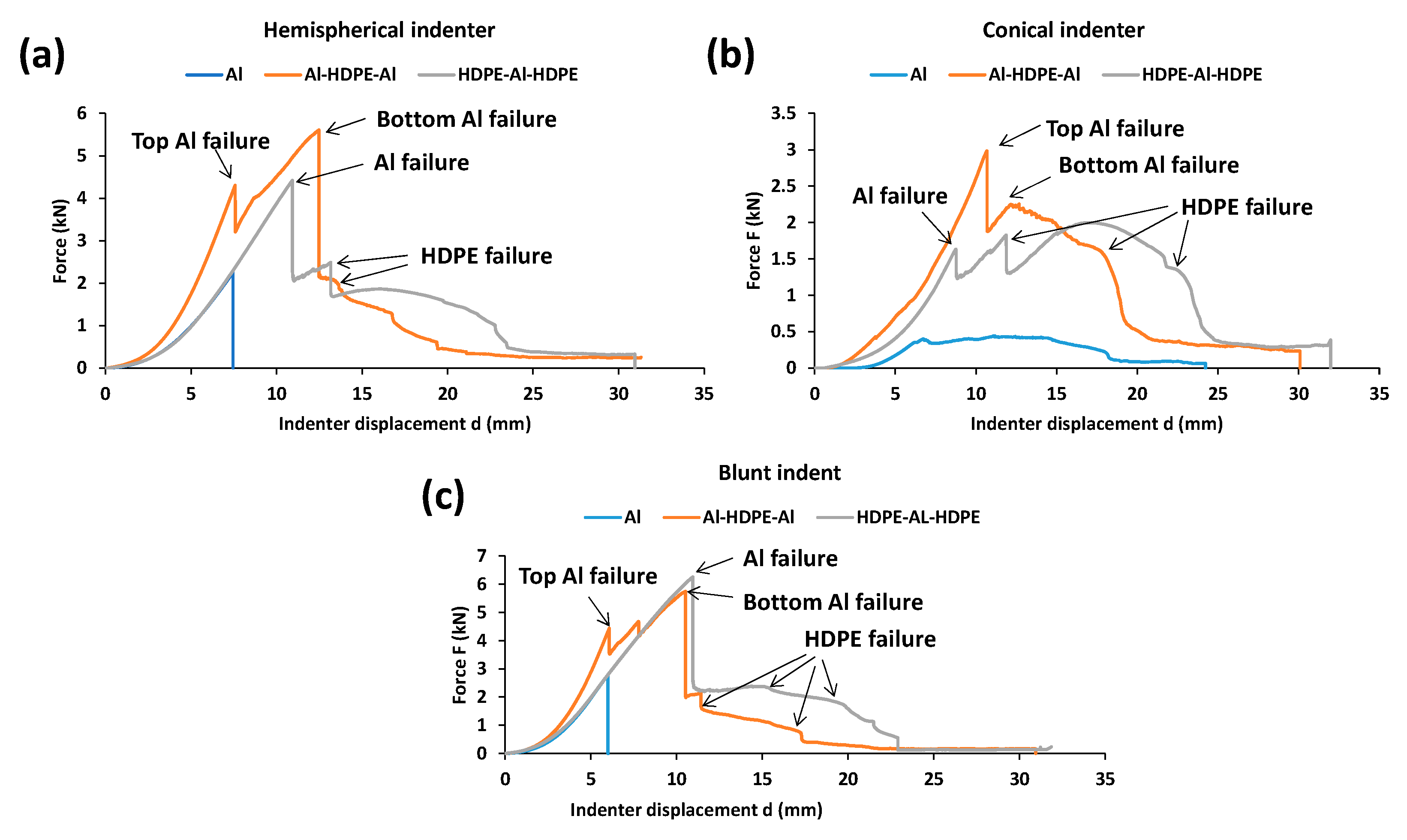


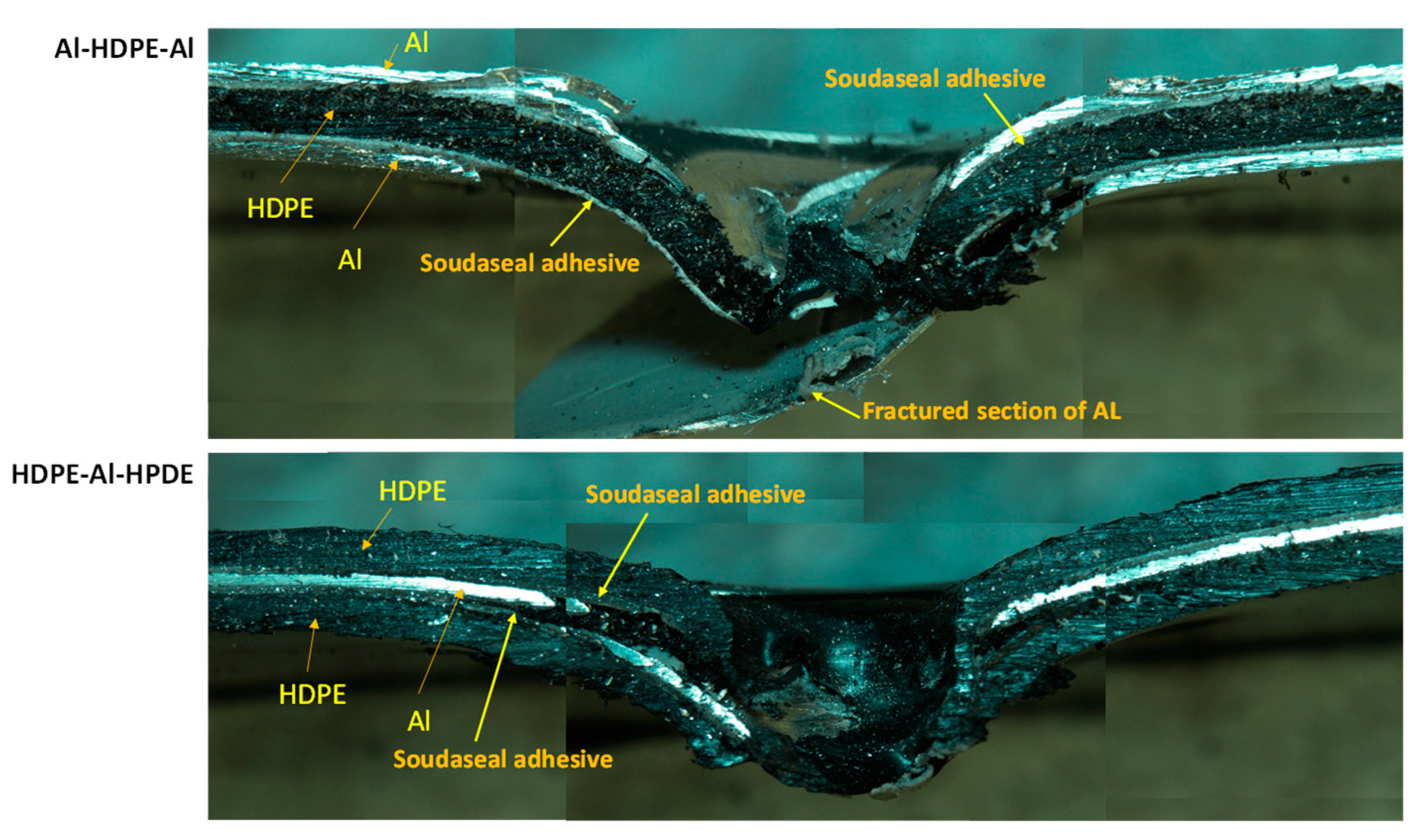
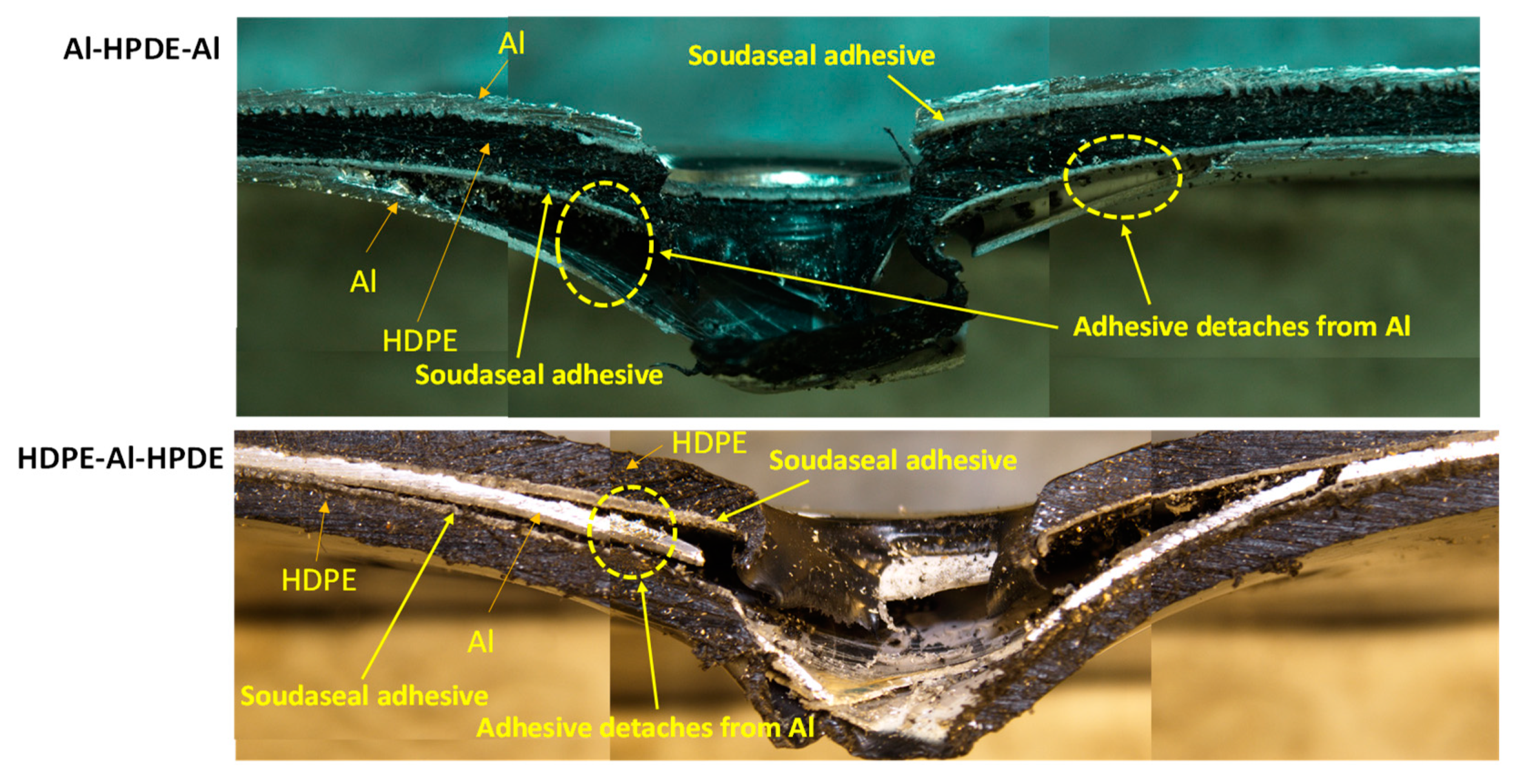


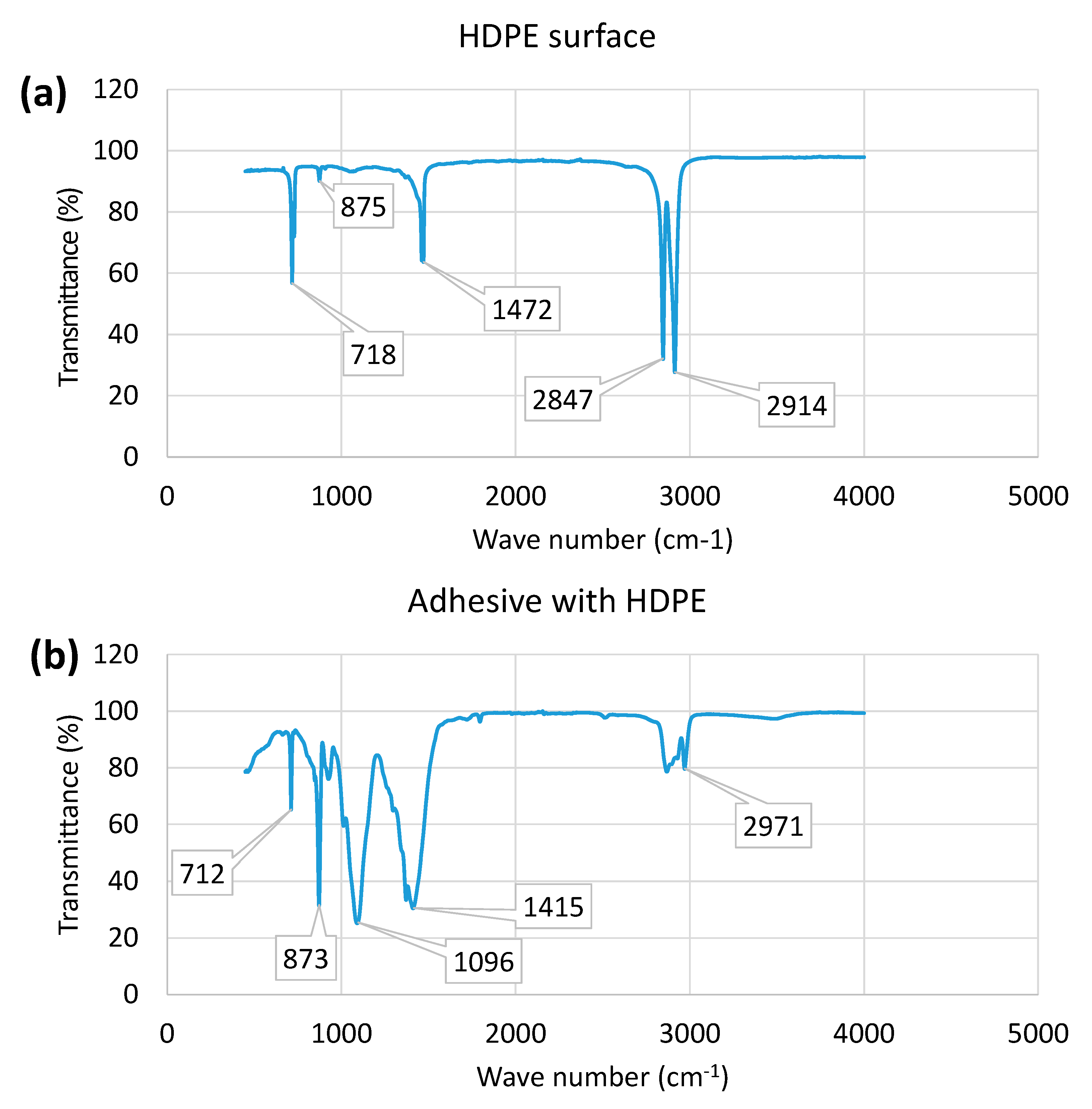
| Material | Product Name | Thickness (mm) | Density (kg·m−3) | Young’s Modulus (GPa) | Yield Strength (MPa) | Nominal Failure Strain |
|---|---|---|---|---|---|---|
| Aluminium 7075-T6 | AMS 4049 | 0.5 | 2810 | 72 | 503 | 0.11 |
| HDPE | HDPE | 1.5 | 960 | 1.2 | 26 | 13.5 |
Publisher’s Note: MDPI stays neutral with regard to jurisdictional claims in published maps and institutional affiliations. |
© 2022 by the authors. Licensee MDPI, Basel, Switzerland. This article is an open access article distributed under the terms and conditions of the Creative Commons Attribution (CC BY) license (https://creativecommons.org/licenses/by/4.0/).
Share and Cite
Uddin, M.; Stevens, G.; Williams, D. Effect of Indenter Nose Shape and Layer Configuration on the Quasi-Static Perforation Behaviour of Metal–Plastic Laminates. Materials 2022, 15, 5879. https://doi.org/10.3390/ma15175879
Uddin M, Stevens G, Williams D. Effect of Indenter Nose Shape and Layer Configuration on the Quasi-Static Perforation Behaviour of Metal–Plastic Laminates. Materials. 2022; 15(17):5879. https://doi.org/10.3390/ma15175879
Chicago/Turabian StyleUddin, Mohammad, Graham Stevens, and Daniel Williams. 2022. "Effect of Indenter Nose Shape and Layer Configuration on the Quasi-Static Perforation Behaviour of Metal–Plastic Laminates" Materials 15, no. 17: 5879. https://doi.org/10.3390/ma15175879
APA StyleUddin, M., Stevens, G., & Williams, D. (2022). Effect of Indenter Nose Shape and Layer Configuration on the Quasi-Static Perforation Behaviour of Metal–Plastic Laminates. Materials, 15(17), 5879. https://doi.org/10.3390/ma15175879







